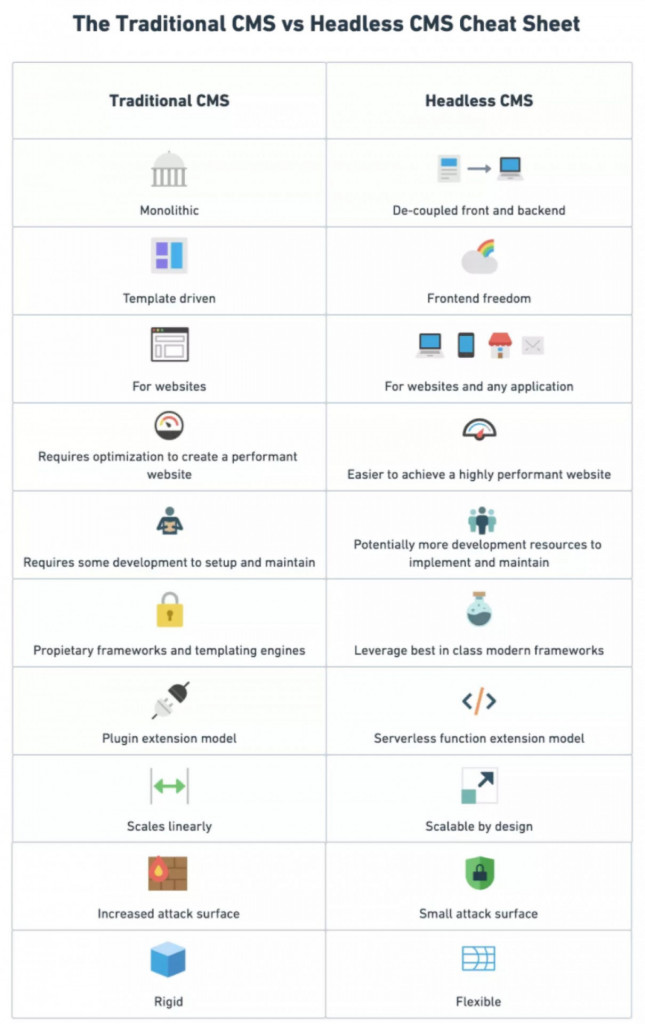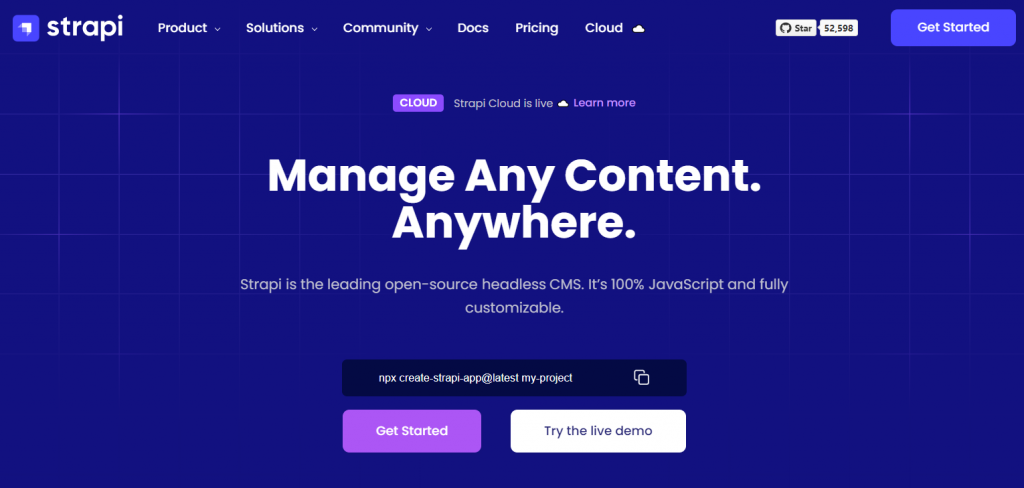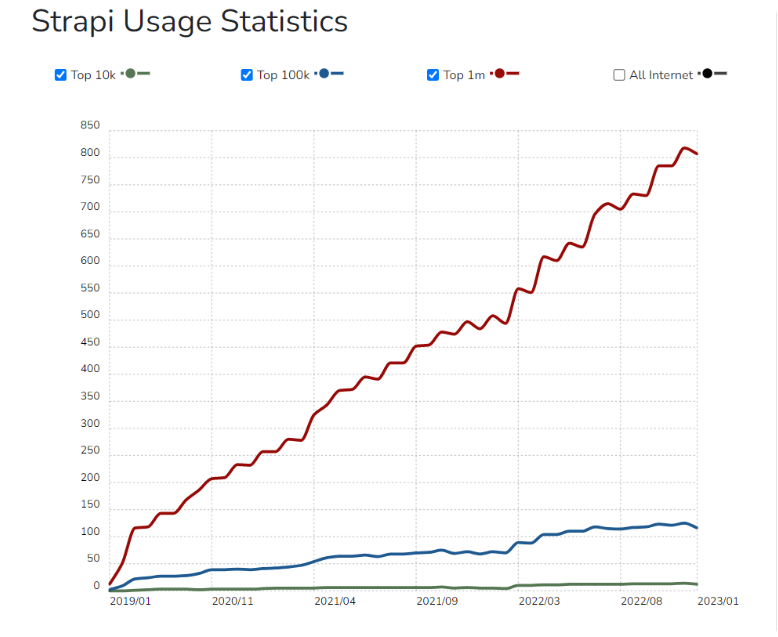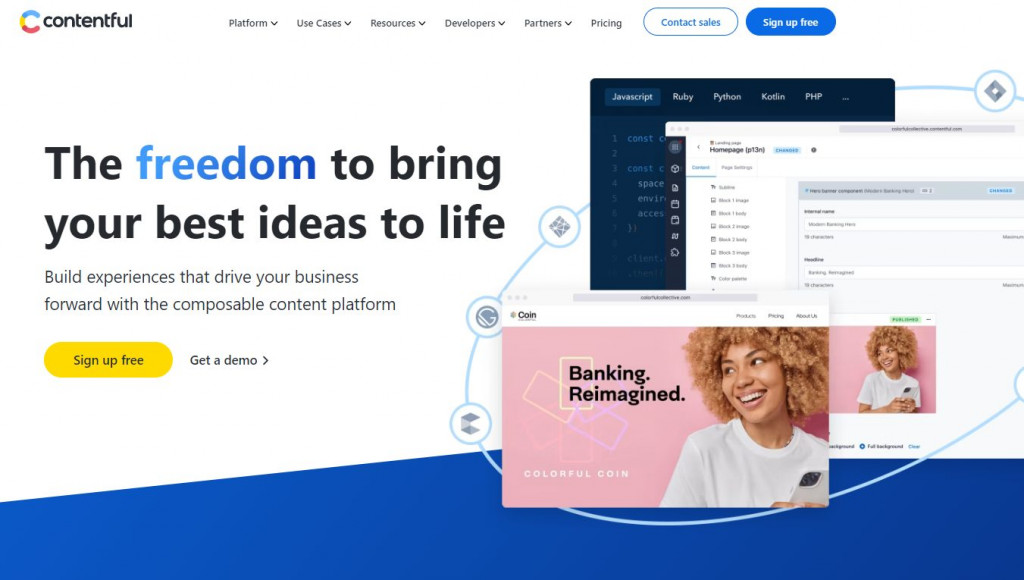Contentful vs Strapi vs WordPress: Which One to Choose
There are many CMS available on the market nowadays. They are roughly divided into headless and traditional. Choosing a cms system can be crucial for your website functioning and business results. For instance, if you need a CMS with great eCommerce features, your choice will obviously differ from that you make for blogging, etc.

First, consider your needs, budget, and CMS available. Strapi, Contentful, and WordPress are our clients’ most widely chosen content management systems. So, if you’re looking for a powerful content management system or an easy-to-use platform, we’re here to help define which one will fit your project’s personal needs the best.
Prior to picking your ideal CMS, discover the differences of both CMS types.
What is a headless CMS?
A headless CMS is a back-end-only content management system (CMS) that makes content available via a RESTful API or GraphQL API for display on any device.
This is a type of content management system that stores and manages data in one centralized hub, but does not make it available to end users. Due to the fact that the back-end and front-end are separated, changes on one side do not necessarily require changes on the other. Instead, the interface presentation layer is handled by a separate application.
Simply put, a headless CMS is an internal content management system that delivers data via an API (Application Programming Interface) and focuses solely on the content part and not on the design.
Strapi and WordPress belong to the headless CMSs. In fact, WordPress is the most flexible CMS that allows you to create almost any type of business website. Its open-source nature means that you can use WordPress as a headless CMS, though some still refer it to the traditional ones.
Contentful is a headless content management system and content platform that is both cloud-native and highly extensible which is actually often defined as a composable content platform — not a CMS that can do everything a traditional CMS can do, but being a next generation technology going well beyond legacy CMS capabilities.
A composable content platform orchestrates content from various sources and delivers it to any digital channel thanks to its API-first architecture. Thus, it fulfils the specific requirements of the teams creating and using digital content.
Pros
First, the headless approach allows developers to separate the internal and external parts of the website, making it easier to manage and update content.
Second, it allows content to be delivered to multiple devices and platforms using a single server.
It provides more flexibility in the content presentation. For example, a headless CMS can power a website, a mobile app, or even a voice assistant like Amazon Alexa.
Third, it makes it easier to update the front end of a website without affecting the server side.
This makes the development process more efficient and reduces the risk of breaking existing features.
Fourth, it can improve the website’s performance because the server side is not responsible for rendering the pages.
Finally, a headless CMS is often more scalable than a traditional CMS because it can handle large amounts of traffic without requiring additional resources.
Headless CMS uses an API to deliver content to various devices and platforms.
As a result, headless CMSs are becoming increasingly popular with developers and site owners who need to manage large amounts of content. Mind that.

Source: Squeeze Growth
Cons
We could emphasize that headless requires more technical knowledge to build and set up, but we should also add, that for content authors it is as easy to use as traditional CMS.
In addition, UI frameworks usually have to be rebuilt after the content change and it can be tricky and only a few frameworks and hosting services provide automatic solutions. For example, Gatsby.js and their incremental builds.
What is a traditional CMS?
Traditional CMS is called a monolith that connects a website’s front and back ends in a tidy and simple application code base. They are made up of the presentation layer all the way up to the content database.
The database is connected to the front end, where the material is presented, for example, through a PHP application code.
Check out the scheme to get the idea:

Source: Google
Pros
No reliance on developers is required because the system is designed in a single language and can be managed by a single technical expert.
Marketers may produce content using templates without the help of developers.
Low entry hurdles for programmers and content makers.
Cons
They produce just content for websites (other devices cannot readily receive the same content).
Do not scale well every time.
They require CMS-specific developers.
These CMSs often have restricted adaptability.
Maintenance and improvements will take more time and money in the future.
Difference between Headless CMS and Other (Traditional CMS) Infographics
A headless CMS only manages the content, unlike standard CMS, which seeks to be a single solution for managing both the content and the front-end. Here’s a full comparative chart:

Source: Ultracommerce.co
Strapi, Contentful, & WordPress CMS Overview
Now, let’s have a better look at some of the best headless CMS more often chosen at Fireart to see how they can stack up against each other to pick the right one for your particular project:
Strapi: Pros and Cons

Strapi is an open-source, headless content management system (CMS) written in JavaScript that allows you to easily create and manage your website content. Open-source nature means you can install your own server and use an API to configure the front and back end.
Creating projects in Strapi should be one of the fastest ways to get as a developer. And with omnichannel capabilities, it gives you the ability to scale your projects as they grow. Is Strapi suitable for large projects? In fact, scalability and flexibility are two of key Strapi features, which make it a great fit for bigger projects with a lot of unique requirements and a lengthy development cycle, among other Strapi pros and cons.
Flexible & extensible admin panel
Strapi provides a flexible and extensible admin panel that allows you to manage your content, users, and settings easily. In addition, Strapi has a wide range of features, including a built-in SEO tool, social media integration, and multi-language support.
Open-source & self-hosted
Since Strapi is a self-hosted CMS, you have the freedom to select your hosting service. As a result, you continue to have full control over your data and won’t be tied to the vendor. You can transfer your data to another CMS. The platform can support third-party hosting providers through integrations.
One of the latest features of Strapi, is the possibility to have a managed service (hosted by a provider), and therefore doesn’t require any tech knowledge to maintain. However, mind that this is paid feature.
Authentication & authorization plugin
It enables the installation of plugins for permissions and roles. As its name implies, this plugin offers restricted access by controlling procedures like sign-ups, logins, and password resets. Working as a team allows you to control who gets access to particular data. Also, you can set up your open authentication (OAuth) to make engaging securely with third-party services easier.
Security
Strapi has built-in security safeguards that safeguard user data and your data. It is secure and reliable because of features like JWT authentication and role-based access management.
Community
Strapi is reportedly used by about 80 companies worldwide in their IT stacks that operate in various industries. Among them, there are IBM, Asos, and Walmart. In addition, Trade Republic is a German investment firm, Mind Gym, which provides behavioral science services, and many others.
(Source: Strapi.io)
It has a solid and vibrant community and support that can assist you with any issues or questions you may have, is easy to learn and apply.

Source:Trends.builtwith
Starpi features list
- Open source
- Self-managed
- Authentication & authorization plugin
- Flexible and extensible admin panel
- Intuitive user interface
- Built-in SEO Tool
- Built-in internationalization
- Omnichannel capabilities
- Role Based Access Control (RBAC) system support allows an admin to configure permissions.
Three positions are available on the platform:
- super admin,
- editor,
- and author.
Editors can only publish and edit content; super admins can access and control all data. Posting of content created by authors is allowed.
Pros
- Fast and easy to use
- Flexibility and scalability
- Good for blog and static landing pages
Cons
- The free version lack some features
- Challenging to set up
- It is a resource hog
- The learning curve can be steep for beginners
- Limited e-commerce features.
Strapi CMS Pricing
Strapi’s self-hosted plan is free to use, unlocking almost every CMS feature you might need. Or they may yet launch their cloud plan for you. The rates from strapi pricing are below.

Сontentful
What is contentful cms? Contentful is one of the leading headless CMS offering a wide range of contentful features and capabilities. Contentful is cloud-based and therefore ensures that your content is delivered across all digital channels.

First, it is very easy to use, even for non-technical users. Contentful cms management is intuitive. It also integrates well with a wide range of tools, making it easy to post content anywhere you need it. And its application framework makes it easy to create custom applications that need access to your content.
With the given templates, you may create bespoke content models and incorporate a number of third-party services to enhance workflow and top-notch user experience.
Plus, its customizable interface allows you to give your content team the freedom you need while maintaining control over your brand.
The platform allows for the collaborative editing of almost any type of content, including blogs, photos, and even music, by a group of editors with access to different roles. Moreover, Contentful supports GraphQL and REST APIs, allowing for content delivery via various channels like websites, mobile apps, and IoT devices.
Also, to take full control of your content, you can use its powerful content management API with compact JSON payloads.
CDN
A distributed server network called a CDN seeks to give users quick access to content. The network also uses advanced caching to improve site performance. The Contentful CDN is designed for quick, 24/7 content delivery. It employs the CloudFront and Fastly CDNs, which are also employed by well-known businesses like Twitter, Vimeo, and Github. A JSON document from the CDN meets every request.
Straightforward UI
Even for those with no prior experience in software development, Contentful user interface is simple and easy to use. Also, the platform enables a wide range of UI extensions for better functionality and customization. Finally, creating mobile-friendly custom content types is a breeze with Contentful.
Customization toolkit
Contentful offers a toolset for personalizing content. This enables you better readability and customization for your content model to match your company objectives. You can add custom fields; fill up these custom fields while writing blog articles so that the data is arranged understandably. To guarantee that your audience sees new content on time, you can also publish content in several time zones and languages with just one click.
Sharing assets
Every content must go through a lengthy censorship and revision process before it is published. Since this process frequently occurs offline, it is typically laborious and time-consuming. Yet, Contentful is designed to maximize in-the-moment collaboration and lets users build content libraries with controlled access and share between the participants of the process under particular roles. Thus, editors and developers can work on a different section of the blog before merging their modifications in production.
Autonomy
If you need regional autonomy, they have your back. For example, you can publish your content in multiple languages by synchronizing the respective time zones.
Contentful features list
- Intuitive interface
- Powerful API
- Customization
- Regional autonomy
- Mobile friendly
Pros
- Easy to use
- Fast performance
- Great for multilingual sites
- Content management and distribution unification
- Flexibility and scalability
- Contentful pricing comparison with others
Cons
- Limited on the number of content types you can use
- Lack of resources for entry-level coders
- Integration with Grammarly could be improved
- Needs more customer support.
Contentful Pricing
Contentful offers three pricing tiers: community, team, and premium:

Pros and Cons of WordPress
WordPress is a popular content management system (CMS) that can be used for managing everything from small personal blogs to large corporate websites. WordPress has recently been increasingly used as a headless CMS, meaning that the back end of WordPress stores and manages content while the front end is built using a separate framework or platform. This approach offers more WordPress benefits rather than disadvantages of WordPress, including greater flexibility and easier integration with other systems.

Self-hosting
In terms of ownership and use, WordPress is very adaptable. You can create a website using WordPress without having to host it there, giving you the flexibility to host it elsewhere. Data ownership and control make server relocation simple.
Flexible front-end
One of the benefits of using WordPress as a headless CMS is that it allows for a lot of flexibility in terms of front-end. Front-end design is limited to the chosen theme on a traditional WordPress site. However, when using WordPress as a headless CMS, the front end can be customized entirely as it is not tied to any particular theme. This means developers can create unique and compelling user interfaces without worrying about compatibility issues.
Multisite integrations
Another benefit of using WordPress as a headless CMS is that it easily integrates with other systems. For example, if you want to add an e-commerce component to your website, you can easily do so using one of the many plugins available. For a traditional WordPress site, you will need to develop your own solution or use a third-party service such as WooCommerce, etc. However, since WordPress as a headless CMS separates the front-end and back-end, it is much easier to integrate with existing systems.
Media management tool
With WordPress, it’s simple to both store and embed media. To use them repeatedly, you can store media files in your WordPress library. You can now easily submit alt text, insert photos, and more using the straightforward drag-and-drop uploader.
Plugins
One of its best aspects is how simple it is to create extra site components using over 50,000 plugins available. Consider plugins as supplemental programs and applications that are created to enhance and carry out particular functions for your website. For whatever necessity, whether it is widgets, social network integration, spam blocking, scheduling calendars, SEO, or landing page forms, there are literally thousands of plugins created to operate with WordPress making it one of the real advantages of using WordPress.
SEO friendly
Finally, WordPress is the recommended tool for building SEO-friendly websites since, in contrast to many other site builders, it is designed for search engine optimization. WordPress produces correct HTML pages that are simple for search engines to understand in its bare-bones version, and it is even integrating HTML5 to remain ahead of the competition. WordPress also helps to generate title tags, headers, and permalinks that are search engine friendly. However, mind that in headless mode devs are in charge of the HTML template and meta tags.
WordPress features list
- Integration
- User management
- Media toolkit
- Seo plugins
- Theme customization
- WordPress premium features
- E-commerce plugins
Pros
- Open source and free to use
- Flexible to create different website types
- Separated interface and back end
- You own/control your data
- Easy-to-customize basics
- Large plugin ecosystem
- SEO friendly
- Good documentation
- Greater flexibility in terms of exterior design
- Easy integration with other systems
- CMS support
Cons
- Can be overwhelming for some users
- Essential backups, updates, and security are self-managed
- Live customer support available if hosted on WordPress.com only
- A lot of useful plugins are not free (For example for internationalization).
- Not every plugin will be compatible with GraphQL
WordPress Pricing
As WordPress is so widely used for creating websites, the majority of the integrations are also available for free download.

FAQ
How to choose the right cms?
All of these platforms have their own unique strengths and weaknesses, so you need to choose the one that suits your specific needs. However, below are some of the factors to consider when choosing a headless CMS. To help you make the right decision, consider the following factors first:
- Define your goals
- Consider your technical skill level
- Estimate your budget
- Consider the frequency of updates
- Think about third-party integrations
What is the best cms for web development?
WordPress. WordPress is the most widely used CMS platform, being used by more than 43.2% of all websites. Strapi and Contentful are another most popular. These were the ones we specifically select since they are also good CMS for developers, which may have certain requirements.
Can eCommerce benefit from a headless CMS?
In order to create the customer-facing component of your platform while keeping a strong back-end, headless CMS gives you more freedom and scalability. Separating the front-end and back-end of eCommerce apps is also supported.
Conclusion
With a suitable headless CMS, you can start with the project being assured that your site content will be in the best environment. Now that you have familiarized yourself with the pros and cons of some of the top headless CMS options most frequently used, it’s time to decide which is ideal for your business needs. WordPress, Contentful or Strapi are recommended for a good start. All are versatile, and you will most likely find them to suit your needs. Let us help you in all possible ways. By taking the time to assess them, we will assist you in choosing the right platform for your project faster and better. Just give us a call any time.





















